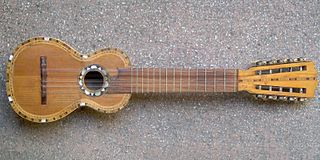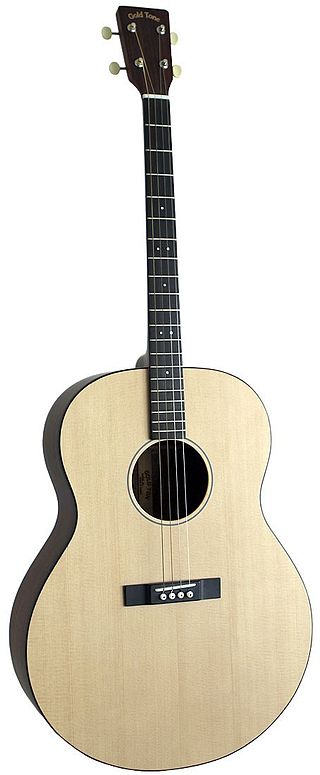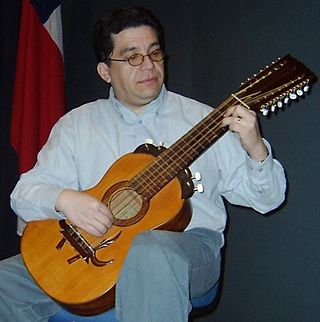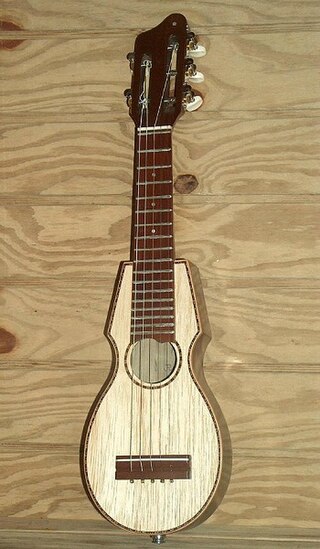
A mandolin is a stringed musical instrument in the lute family and is generally plucked with a pick. It most commonly has four courses of doubled strings tuned in unison, thus giving a total of eight strings. A variety of string types are used, with steel strings being the most common and usually the least expensive. The courses are typically tuned in an interval of perfect fifths, with the same tuning as a violin. Also, like the violin, it is the soprano member of a family that includes the mandola, octave mandolin, mandocello and mandobass.

The charango is a small Andean stringed instrument of the lute family, from the Quechua and Aymara populations in the territory of the Altiplano in post-Colonial times, after European stringed instruments were introduced by the Spanish during colonialization. The instrument is widespread throughout the Andean regions of Bolivia, Peru, Ecuador, northern Chile and northwestern Argentina, where it is a popular musical instrument that exists in many variant forms.
The tres is a three-course chordophone of Cuban origin. The most widespread variety of the instrument is the original Cuban tres with six strings. Its sound has become a defining characteristic of the Cuban son and it is commonly played in a variety of Afro-Cuban genres. In the 1930s, the instrument was adapted into the Puerto Rican tres, which has nine strings and a body similar to that of the cuatro.

The Appalachian dulcimer is a fretted string instrument of the zither family, typically with three or four strings, originally played in the Appalachian region of the United States. The body extends the length of the fingerboard, and its fretting is generally diatonic.
The term requinto is used in both Spanish and Portuguese to mean a smaller, higher-pitched version of another instrument. Thus, there are requinto guitars, drums, and several wind instruments.

A tiple, is a plucked typically 12-string chordophone of the guitar family. A tiple player is called a tiplista. The first mention of the tiple comes from musicologist Pablo Minguet e Irol in 1752. Although many variations of the instrument exist, the tiple is mostly associated with Colombia, and is considered the national instrument. The Puerto Rican version characteristically has fewer strings, as do variants from Cuba, Mallorca, and elsewhere among countries of Hispanic origin.

The Irish bouzouki is an adaptation of the Greek bouzouki. The newer Greek tetrachordo bouzouki was introduced into Irish traditional music in the mid-1960s by Johnny Moynihan of the folk group Sweeney's Men, who retuned it from its traditional Greek tuning C³F³A³D⁴ to G²D³A³D⁴, a tuning he had pioneered previously on the mandolin. Alec Finn, first in the Cana Band and subsequently in De Dannan, introduced the first Greek trichordo (3 course) bouzouki into Irish music.

The tenor guitar or four-string guitar is a slightly smaller, four-string relative of the steel-string acoustic guitar or electric guitar. The instrument was initially developed in its acoustic form by Gibson and C.F. Martin so that players of the four-string tenor banjo could double on guitar.
In music, standard tuning refers to the typical tuning of a string instrument. This notion is contrary to that of scordatura, i.e. an alternate tuning designated to modify either the timbre or technical capabilities of the desired instrument.
The cuatro is a family of Latin American string instruments played in Colombia, Puerto Rico, Venezuela and other Latin American countries. It is derived from the Spanish guitar. Although some have viola-like shapes, most cuatros resemble a small to mid-sized classical guitar. In Puerto Rico and Venezuela, the cuatro is an ensemble instrument for secular and religious music, and is played at parties and traditional gatherings.

Laúd is a plectrum-plucked chordophone from Spain, played also in diaspora countries such as Cuba and the Philippines.
The octophone is a stringed musical instrument related to the mandola family resembling an octave mandolin. It was marketed by Regal Musical Instrument Company, who introduced it 21 January 1928, as an "eight-purpose instrument".

The Guitarrón Chileno is a guitar-shaped plucked string instrument from Chile, with 25 or 24 (rarely) strings. Its primary contemporary use is as the instrumental accompaniment for the traditional Chilean genre of singing poetry known as Canto a lo Poeta, though a few virtuosi have also begun to develop the instrument's solo possibilities.

The octavina or Ecuadorian-Peruvian octavina is a guitar-shaped Ecuadorian-Peruvian instrument with a tuning similar to the laúd. Originally a Spanish instrument, the octavina was soon incorporated into other cultures, notably including culture of Ecuador and culture of Peru.

The Guitolão is a chordophone designed by Portuguese luthier Gilberto Grácio. It is a baritone version of the Portuguese guitar.

The Colombian tiple is a plucked string instrument of the guitar family, common in Colombia where it is considered one of the national instruments. About three-fourths the size of a classical guitar, it has twelve strings set in four triple-strung courses. It is played as a main instrument or as an accompanying instrument to the guitar.
The Guitarra de golpe is a stringed musical instrument from Mexico. It has 5 nylon strings in 5 courses. The headstock traditionally has a traditional shape that is designed to look like a stylised owl with wooden pegs, but nowadays this is sometimes replaced with a guitar or vihuela style headstock with machine heads. For a while during the 20th century, the Guitarra De Golpe fell into disuse in traditional Mariachi groups, and was replaced by the Classical guitar. It has now however been revived. It is still an essential part of the "conjuntos de arpa" from Michoacán.
The viola da Terceira is a stringed musical instrument of the guitar family, from the Portuguese islands of the archipelago of the Azores, associated with the island of Terceira.

The tiple is the smallest of the three string instruments of Puerto Rico that make up the orquesta jibara. According to investigations made by Jose Reyes Zamora, the tiple in Puerto Rico dates back to the 18th century. It is believed to have evolved from the Spanish guitarrillo. There was never a standard for the tiple and as a result there are many variations throughout the island of Puerto Rico. Most tiples have four or five strings and most tiple requintos have three strings. Some tiples have as many as 6 strings and as few as a single string, though these types are rare.
A Sanjuanito, Sanjuan, or San Juan is a type of Ecuadorian music and dance. Sanjuanitos are an indigenous form of music and folkloric dance associated with the Sierra, Ecuador's mountainous Andean region. It's associated with, but not specific to, the Otavalo people.












